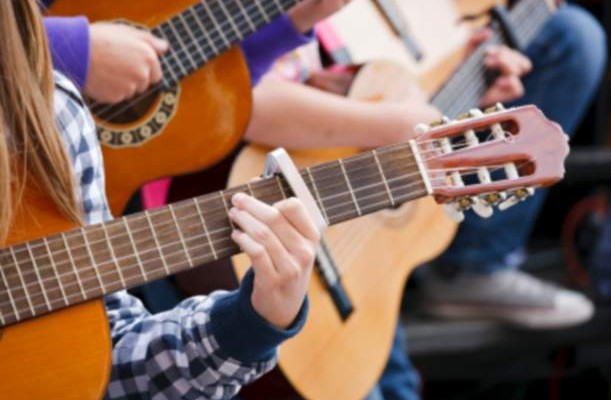Learning to play the guitar is a goal shared by countless people around the world. Whether it’s the desire to strum classic rock chords, play soulful blues, or compose original tunes, the guitar holds a universal appeal. While private one-on-one lessons are common, group guitar lessons have been gaining popularity—and for good reason.
These collaborative sessions go beyond simply learning notes and scales. They build community, boost motivation, and foster a sense of musical camaraderie that solo learning often lacks. Whether you’re a complete beginner or an intermediate player, group guitar classes can provide a dynamic and rewarding musical journey.
The Unique Experience of Group Guitar Learning
Group guitar lessons are structured around learning as a collective. Unlike traditional lessons where one teacher focuses on a single student, group settings involve multiple learners of similar skill levels guided by a single instructor.
This environment fosters shared growth. When you hear others tackle the same challenges you face, it reinforces your progress and gives you fresh perspectives. The interaction, mutual support, and even the friendly competition in group sessions can greatly enhance your musical development.
Benefits of Group Guitar Lessons
Learning Through Collaboration
Humans are naturally social learners. In group guitar lessons, students benefit not only from the instructor but also from their peers. You can learn from each other’s mistakes, share tips, and discover alternative ways to approach difficult chords or finger placements.
Boosted Confidence
Playing guitar in front of others can be intimidating, especially for beginners. Group lessons gently ease students into performing in front of others, helping to develop stage confidence in a relaxed setting.
More Affordable Option
Typically, group lessons are more cost-effective than private tuition. This makes them an excellent choice for learners on a budget who still want structured, high-quality instruction.
Increased Motivation
Being part of a group creates accountability and encouragement. When you know others are practicing and progressing, you’re more likely to stay committed and push through challenges.
Introduction to Ensemble Playing
Group sessions often involve duets, rhythm-guitar and lead-guitar roles, and ensemble play. This provides early exposure to playing in a band-like setting, an invaluable skill for anyone aspiring to perform or jam with others.
What to Expect in a Group Guitar Lesson
Warm-Up Exercises
Every lesson typically starts with finger exercises and basic warm-ups. These help improve dexterity and prepare the hands for more complex playing.
Chord Progressions and Scales
The core of many group guitar sessions revolves around learning essential chord shapes, progressions, and major/minor scales. Students play along together while the instructor corrects posture, strumming, and timing.
Strumming Patterns and Rhythm
Understanding rhythm is critical for guitarists. Group settings are perfect for practicing consistent strumming patterns in sync with others. It sharpens timing and rhythm, often more effectively than solo practice.
Song Practice
In most group classes, students learn to play full songs together. The class may split into rhythm and lead parts or simply strum chords in unison. This reinforces the fun and gives a sense of real accomplishment.
Jam Sessions and Improvisation
More advanced group lessons often include jam sessions, where students improvise over a common progression. This not only nurtures creativity but also builds comfort in musical spontaneity.
Who Should Consider Group Guitar Lessons?
Beginners
Group lessons are ideal for beginners who might feel overwhelmed by one-on-one attention. Learning alongside peers helps reduce pressure and adds fun to the process.
Intermediate Players
Those who already know the basics can benefit from refining their skills, learning to collaborate musically, and even helping beginners—which reinforces their own knowledge.
Children and Teens
Young learners especially thrive in interactive, social environments. Group guitar lessons teach discipline, focus, and teamwork, all while nurturing a love for music.
Adults and Seniors
It’s never too late to learn an instrument. Group guitar lessons provide adults with a relaxed, communal setting where learning is as much about joy and connection as it is about progress.
Choosing the Right Group Class
When selecting a group guitar class, consider the following:
- Skill Level Matching: Ensure the group aligns with your current ability to avoid frustration or stagnation.
- Class Size: Smaller groups (4–8 students) offer better individual attention.
- Instructor’s Approach: Look for teachers who balance structure with flexibility and foster an encouraging environment.
- Musical Style: Whether you’re into pop, classical, rock, or jazz, find a class that resonates with your genre interests.
Tips for Success in Group Guitar Lessons
- Be Patient: Everyone progresses at their own pace. Celebrate small wins.
- Ask Questions: Don’t hesitate to seek clarification during or after class.
- Practice Regularly: Group lessons are more impactful when you maintain a personal practice routine.
- Record Sessions: Use your phone to record snippets (with permission) so you can revisit tricky parts.
- Engage with Your Peers: Build friendships, swap music ideas, and support each other outside the class.
The Joy of Shared Music
Learning guitar doesn’t have to be a solo pursuit. In fact, music is inherently social—and group guitar lessons beautifully reflect that truth. By learning together, students not only acquire new skills but also forge connections, build confidence, and gain the tools to eventually perform in ensembles, jam sessions, or even bands.
Whether you dream of strumming songs by the campfire, performing on stage, or simply expanding your musical horizons, group guitar lessons offer a fun, fulfilling, and affordable path to reach those goals. And perhaps most importantly, they remind us that music is best enjoyed together.


